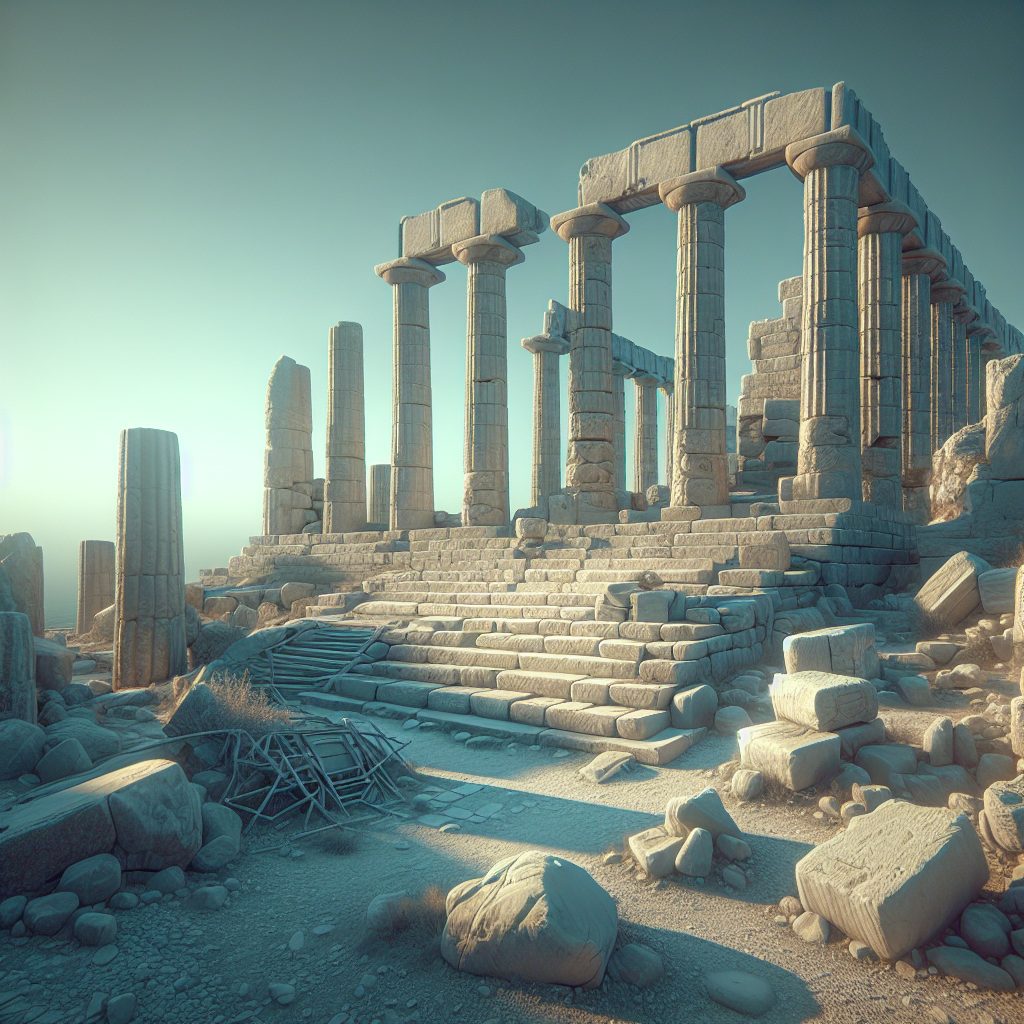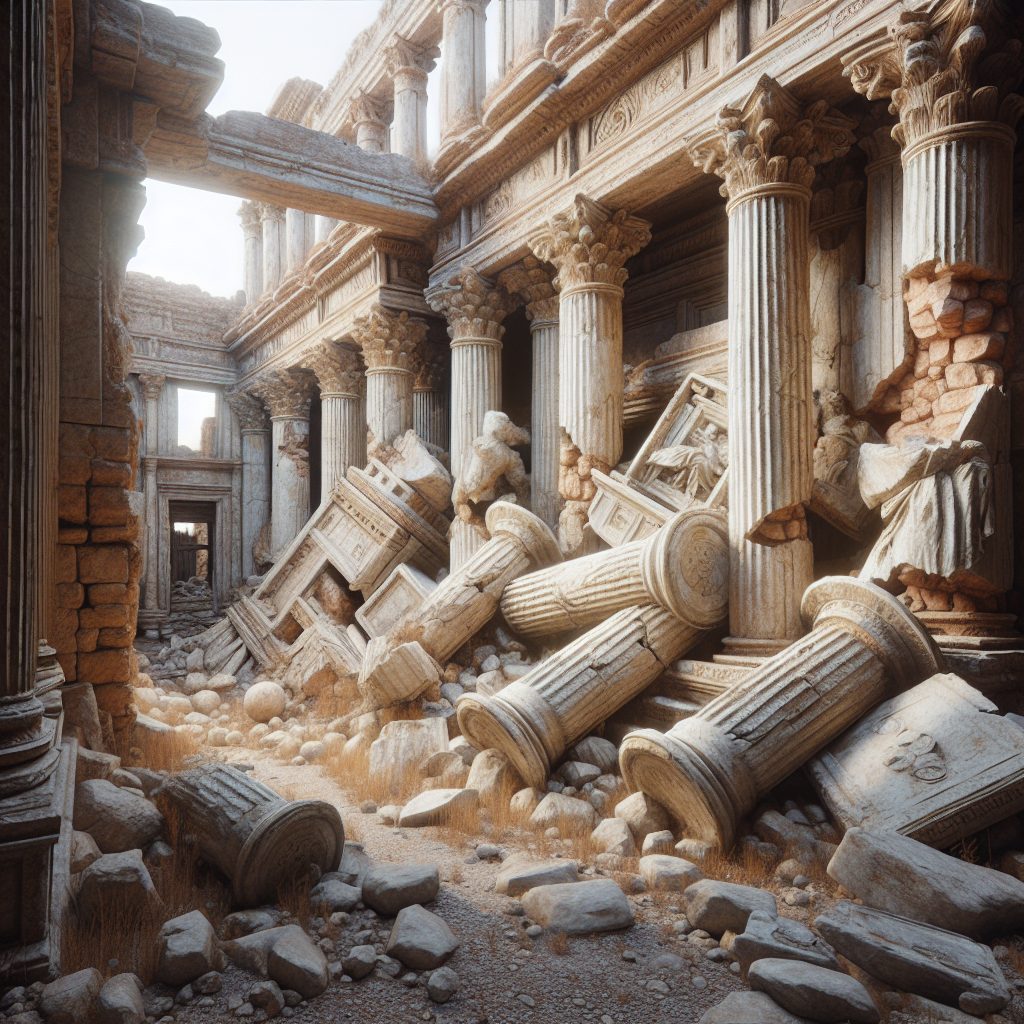Tharros temple ruins are a captivating site located on the western coast of Sardinia, Italy. Dating back to the 8th century BC, these ancient ruins offer a glimpse into the rich history and architectural prowess of the Phoenician civilization. The term “Tharros” derives from the Phoenician word for “tower,” highlighting the impressive structures that once stood here.
These temple ruins hold great significance as they showcase the Phoenician influence on the development of Sardinia. The Phoenicians, renowned seafarers and traders, established colonies along the Mediterranean coasts, and Tharros served as a strategic port for their maritime activities. The ruins bear witness to the unique blend of Phoenician and local Nuragic culture, making them a treasure trove for historians and archaeologists alike.
Moving forward, we will delve into the key takeaways from the Tharros temple ruins. We will explore the architectural marvels that have survived the ravages of time, providing insights into the construction techniques employed by the Phoenicians. Additionally, we will uncover the historical significance of Tharros as an important center for trade and cultural exchange. Join us as we unravel the mysteries of this ancient site and gain a deeper understanding of the Phoenician legacy in Sardinia.
Key Takeaways
1. Tharros temple ruins, located on the western coast of Sardinia, are an important archaeological site showcasing the remains of an ancient Phoenician and Roman settlement.
2. The temple complex at Tharros was dedicated to the goddess Astarte and was an integral part of the religious and cultural life of the community, providing insights into the religious practices of the Phoenicians and Romans in the region.
3. These ruins consist of various structures, including the remains of a large temple, a Roman bath complex, and a necropolis, revealing the different architectural styles and influences that shaped the site over time.
4. Excavations at Tharros have unearthed a multitude of artefacts, such as fragments of statues, pottery, and inscriptions, shedding light on the daily life, trade, and interactions of the ancient inhabitants of the area.
5. Visiting the Tharros temple ruins provides a unique opportunity to explore the layers of history and immerse oneself in the rich cultural heritage of Sardinia, offering a glimpse into the past civilizations that thrived in the region.
What are the Tharros temple ruins and their historical significance?
1. Location and Historical Background
The Tharros temple ruins are an ancient archaeological site located on the western coast of Sardinia, Italy. This site holds immense historical significance, dating back to the 8th century BC during the Phoenician era. Built by the ancient Phoenicians and later occupied by the Romans, the temple ruins provide valuable insights into the civilizations that once thrived in this region.
2. Architectural Marvels of Tharros
The Tharros temple ruins showcase remarkable architectural craftsmanship. The site consists of various structures, including a temple dedicated to the gods, a marketplace, residential areas, and defensive walls. The temple itself features intricate carvings, detailed columns, and beautifully preserved fragments, offering visitors a glimpse into the grandeur of the past.
3. Historical Significance of Tharros
Tharros played a crucial role as a Phoenician trading colony and later became a pivotal Roman city. As a hub of maritime trade, it witnessed the exchange of goods, cultural influences, and economic growth in the Mediterranean region. The ruins provide evidence of the transition from Phoenician to Roman rule and the impact of these civilizations on the site’s development.
4. Cultural and Archaeological Importance
For archaeologists and historians, the Tharros temple ruins are invaluable for studying ancient civilizations. The artifacts uncovered at the site reveal insights into religious practices, societal structure, economic activities, and artistic expressions of the Phoenicians and Romans. These findings contribute significantly to our understanding of Sardinia’s past and its connections to wider Mediterranean history.
5. Visitor Experience and Preservation Efforts
Today, Tharros attracts tourists and history enthusiasts who visit to witness its awe-inspiring ruins. The site offers guided tours to help visitors comprehend its historical context and significance. Efforts are also in place to preserve and protect the temple ruins, ensuring their longevity for future generations to appreciate and learn from.
6. Exploring the Surroundings
Besides the Tharros temple ruins, the surrounding area provides additional attractions and activities. Visitors can explore the nearby beaches, enjoy water sports, or hike along nature trails. The picturesque landscape enhances the overall experience, making it an ideal destination for history lovers and nature enthusiasts alike.
7. Tips for a Memorable Visit
- Plan your visit in advance to maximize your time at the Tharros temple ruins.
- Wear comfortable shoes and bring sun protection as you will be walking and exploring the outdoor site.
- Consider joining a guided tour to gain deeper insights into the historical significance of the ruins.
- Bring a camera or smartphone to capture the beauty and intricate details of the temple ruins.
- Respect the site’s rules and regulations to contribute to its preservation and conservation.
- Combine your visit to Tharros with other nearby attractions to make the most of your trip.
- Immerse yourself in the local culture and cuisine during your stay in Sardinia.
Frequently Asked Questions
1. What is the significance of Tharros temple ruins?
The Tharros temple ruins hold great historical and cultural significance. They are remnants of an ancient Phoenician city and showcase the architectural prowess of the past civilizations.
2. How old are the Tharros temple ruins?
The Tharros temple ruins date back to the 8th century BC, making them over 2,800 years old. They provide valuable insights into the ancient world and its religious practices.
3. Can visitors explore the Tharros temple ruins?
Yes, visitors have the opportunity to explore the Tharros temple ruins. The area is open for public access, allowing people to marvel at the ancient structures and immerse themselves in the historical ambiance.
4. Are there any guided tours available for the Tharros temple ruins?
Yes, guided tours are available for the Tharros temple ruins. These tours often provide in-depth explanations of the site’s history, architecture, and significance, enhancing the overall experience for visitors.
5. Are there any restrictions or guidelines for visiting the Tharros temple ruins?
Visitors must follow specific guidelines when visiting the Tharros temple ruins to ensure their preservation and respect for the site. These guidelines usually include not touching or climbing on the ruins, not littering, and following designated paths.
6. Can I take photographs at the Tharros temple ruins?
Yes, visitors are allowed to take photographs at the Tharros temple ruins. Capturing the beauty and historical value of the site is highly encouraged, but it’s crucial to be mindful of others and avoid causing any damage to the ruins.
7. Is there an entrance fee for visiting the Tharros temple ruins?
The entrance fee for visiting the Tharros temple ruins may vary depending on the specific location and regulations in place. It’s advisable to check with the local authorities or visitor information centers for accurate and up-to-date information on fees.
8. Are there any nearby amenities or facilities for visitors at the Tharros temple ruins?
Yes, there are usually nearby amenities and facilities for visitors at the Tharros temple ruins. These may include restrooms, parking areas, cafés, and souvenir shops, providing convenience and comfort to those exploring the site.
9. What other attractions are in close proximity to the Tharros temple ruins?
Close to the Tharros temple ruins, visitors can find other attractions like the Tharros Archaeological Museum, which exhibits artifacts retrieved from the site, and the beautiful coastline offering picturesque views.
10. Can I make reservations to visit the Tharros temple ruins in advance?
Reservation requirements may vary depending on the specific location and management of the Tharros temple ruins. It’s recommended to check beforehand if reservations are necessary, especially during peak tourist seasons to ensure a smooth visit.
Final Thoughts
The Tharros temple ruins offer a captivating glimpse into a rich and ancient past. Exploring these ruins allows us to connect with our predecessors and comprehend the architectural achievements of bygone civilizations. The site’s historical significance, along with its stunning Mediterranean surroundings, make it a must-visit destination for history enthusiasts and lovers of cultural heritage.
Visiting the Tharros temple ruins provides not only an opportunity to learn about the ancient world but also a chance to embrace the enduring legacy of human ingenuity and creativity. These ruins stand as silent witnesses to the passage of time, reminding us of the value of preservation and our responsibility to safeguard our shared history.






